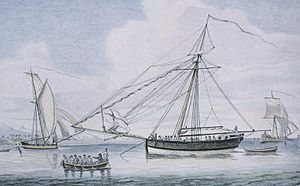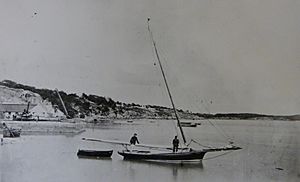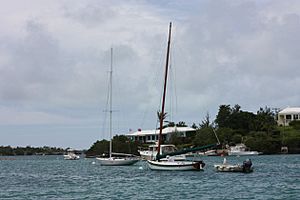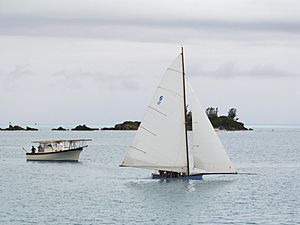Bermuda sloop facts for kids
The Bermuda sloop is a special type of sailing ship. It was developed on the islands of Bermuda in the 1600s. These ships had one mast and used a special kind of sail called a fore-and-aft rig.
At first, Bermuda sloops used square-shaped sails called gaff rigs. But over time, they changed to use triangular sails, which is known as the Bermuda rig. People often think the Bermuda sloop came from the Jamaica sloop. However, the tall, slanted masts and triangular sails of the Bermuda rig actually started in Bermuda much earlier, in the 1600s. What makes a Bermuda sloop special is its unique hull shape, which comes from these old Bermudian designs.
Contents
History of the Bermuda Sloop
- Further information: Bermuda rig
Shipbuilders in Bermuda started making sloops and other ships in the mid-1600s. These early sloops used gaff rigs. The first triangular mainsails, which are a key part of the Bermuda rig, appeared on smaller coastal boats by the 1620s. But most larger ships kept using gaff rigs until the 1820s.
Bermuda sloops were built in many sizes. Some were as long as 70 feet (21 meters). The most common size was about 22 to 28 feet (6.7 to 8.5 meters) long on deck. They also had a very long pole sticking out from the front, called a bowsprit.
Why Bermuda Sloops Were Special
Jamaican sloops were narrower than Bermuda sloops. They could sail very fast, up to about 12 knots. These ships were often built from cedar wood. Bermudian shipbuilders also loved Bermuda cedar. This wood was great because it resisted rot, grew quickly, and marine worms didn't like to eat it. Cedar lasted much longer than oak, sometimes up to 30 years! It was also lighter.
Sloops were perfect for pirates and traders because they could sail in shallow waters. This meant they could hide or escape from bigger ships, like those of the British Royal Navy. Larger ships needed deep water and couldn't follow them.
Later in the 1800s, Bermudian ships mostly stopped using square topsails and gaff rigs. They switched to triangular main sails and jibs. The Bermuda rig was usually for ships with two or more masts. Single-masted ships often used gaff rigs because a single mast needed to be very tall. This meant too much sail area and heavy, weak wooden masts. But with new ideas like hollow masts, single-masted sloops quickly became popular for racing in Bermuda.
Bermuda's ships were made from lightweight Bermuda cedar. They were known for being very quick and easy to steer, especially when sailing against the wind. The tall, slanted masts and long bowsprits and booms let these ships carry huge amounts of sail. This helped them go very fast when sailing with the wind, using extra sails like spinnakers. In the 1800s, small Bermuda sloops were common for moving goods and people around the islands.
Today, the Bermuda rig is used on many small sailing boats. However, modern designs are less extreme than the old Bermudian ones. They have lower, straight masts, shorter booms, and often no bowsprit. This makes them easier to handle.
Bermuda Sloops in Trade and War
The Bermuda sloop became a very popular type of ship for trade. Bermudian traders sailed to many countries. Soon, shipbuilding became a main business in Bermuda. Ships were sold to English colonies in America and the West Indies, and even to Europe.
During the 1700s, Bermudians built about a thousand ships. Many were sold abroad, but Bermuda kept a large trading fleet. These ships, often sailed by enslaved people, carried goods like salt from the Turk Islands to North American ports. They also moved grain, cocoa, and wine between the Atlantic seaboard colonies and the West Indies.
Piracy and Privateering
Piracy was a big problem in the 1600s and 1700s. But during wartime, many Bermudian merchant ships became privateers. Privateers were like legal pirates, allowed by their government to attack enemy ships. Bermuda sloops were perfect for this. Their speed and ability to sail in shallow waters also made them favorites for pirates and smugglers.
These sloops could carry many crew members. This was useful for handling the ship and for taking over captured enemy vessels. The unique design of the Bermuda sloop helped Bermudian sailors succeed. They could escape from bigger, more heavily armed privateers and even large British naval ships. These larger ships, with their square rigs, could not sail as well against the wind. A Bermuda sloop could simply turn into the wind and leave its pursuers behind.
Some historians believe that the many Bermuda sloops built and sold to Americans during the American War of Independence helped the American colonies win their freedom.
People and the Bermuda Sloop
The success of the Bermuda sloop was greatly helped by the skills of Bermuda's free and enslaved Black people. In the 1600s, Bermuda's economy relied on servants who worked for a set time. So, slavery was different than in some other colonies. However, privateers often brought enslaved Black and Native American people captured from enemy ships.
Later, Bermuda focused more on shipping. Enslaved Black, Native American, and Irish people played a bigger role. Black Bermudians became very skilled shipbuilders, metalworkers, and carpenters. Many Black Bermudian shipbuilders, some of whom were enslaved, helped develop shipbuilding in the American South. Their skills influenced the design of ships like schooners.
Because many white Bermudian men were often away at sea, a rule was made. A certain number of Black people had to be part of every Bermudian ship's crew. By the time of the American War of Independence, the many skilled Black sailors greatly added to the strength of Bermuda's merchant fleet. This included the crews of Bermudian privateers.
For example, when Americans captured the Bermudian privateer Regulator, almost all her crew were enslaved Black men. The American authorities offered them freedom. But nearly all 70 captives chose to be treated as prisoners of war. They said slavery was all they knew and feared for their families in Bermuda. They were sent to New York, but they took over the ship and sailed it back to Bermuda.
Slavery was ended in Bermuda in 1834 by the British Government. Before this, the Royal Navy often used Bermuda sloops to stop the trans-Atlantic slave trade. They formed the West Africa Squadron in 1808 to do this.
Bermudian Work Boats Today
The term Bermuda sloop also described the working boats used to move goods around Bermuda's islands. These boats were used for fishing and other coastal activities. Today, the term can mean any single-masted yacht with a Bermuda rig.
Cars were not allowed in Bermuda until after the Second World War. Roads were also not very good. So, boats were the main way to move people and things around Bermuda well into the 1900s.
While large working sloops are rare now, their design led to the Bermuda Fitted Dinghy. This is a class of racing boat used in traditional competitions between Bermudian yacht clubs. Outside Bermuda, the term Bermuda sloop is now used for any single-masted boat with a Bermuda rig. These are also called Marconi sloops. Most modern designs are much less extreme than the old Bermudian ones. They have shorter, straight masts, shorter booms, and no bowsprits. This makes them easier to sail for smaller or less experienced crews.





